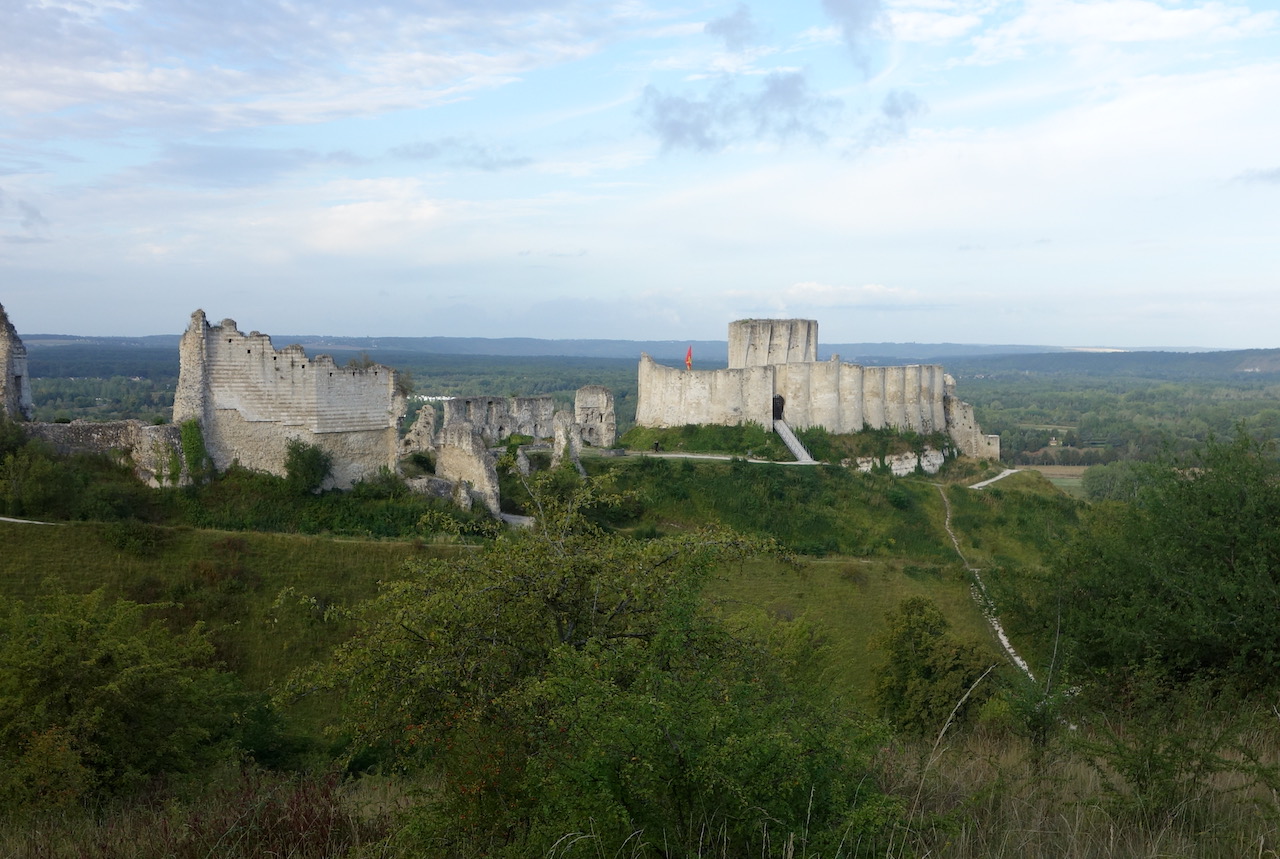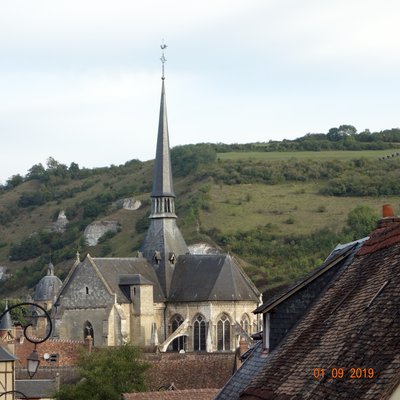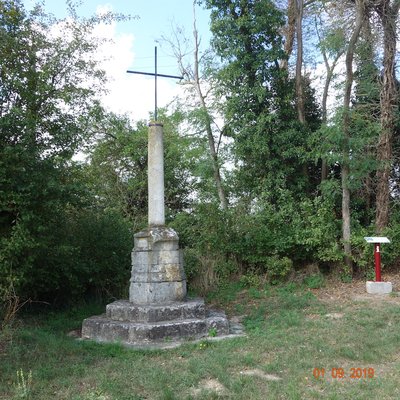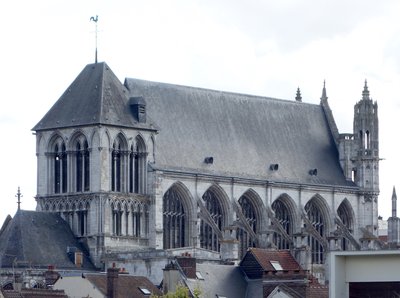Les Andelys to Vernon

Normandie
5. Les Andelys to Vernon
Medium
7h
28,5km
+432m
-421m
Step
Embed this item to access it offline
From Petit Andelys take the time to visit Château-Gaillard and its history then you will reach the plateau with its crops and livestock. You will go down to the right bank of the Seine which has often inspired painters with its chalk cliffs and the islands on the river that decorate the landscape of the valley. A last climb on the plateau to avoid the traffic on the banks of the Seine before discovering the heritage in Vernon.
6 points of interest

L’église Saint-Sauveur du Petit-Andely - Association Colomban en Brie TouristSaint-Sauveur Church du Petit-Andely
Contemporary of Château-Gaillard, it dates from 1202, and has a structure in the shape of a Greek cross. It escaped destruction by becoming a storage place during the revolution. Note the 13th century statue of the blessing Christ on the outside. The choir is gothic, and the organ D'Ingoult dates from 1674.
We invite you to visit the collegiate church Notre-Dame du Grand Andelys. Built in 1225 on the ruins of a women's abbey founded in 511 by Saint Clotilde, wife of Clovis I, it is the oldest attested monastery foundation in Upper Normandy.
Château-Gaillard domine la vallée de la Seine - Association Colomban en Brie HistoricalChâteau-Gaillard in Andelys
The history of the site begins in Gallo-Roman times with the creation of the village of the Andelys.
Richard the Lionheart, King of England and Duke of Normandy, seduced by the position of the site, had Château Gaillard built on a cliff to protect the duchy and Rouen, its capital. A true masterpiece of military architecture ahead of its time, the fortress was not able to withstand the assaults of Philip Augustus in 1204. Taken over by the English during the Hundred Years' War, the fort was definitively abandoned in the face of artillery advances. Stone quarry from 1603, its dismantling ended in 1611.
These majestic ruins of Château-Gaillard inspired the English Romantics, Impressionist painters, poets and contemporary writers.
More info: Wikipedia
Tombeau de saint Ethbin à Port-Mort - Camille56- Wikipédia TouristTomb of Saint Ethbin at Port-Mort
Tradition claims that Saint Ethbin, an Armorican monk who died in Ireland in the 6th century, was buried in the 7th century in the monastery of Port Mort, which was destroyed in the 9th century.
His relics are preserved in a chapel dedicated to him in the church of St Peter (1875). Twice a year, on the Sunday after the Ascension and on October 20th, many pilgrims, after passing under the relics exposed at the church door, went in procession to the dolmen where the holy man was supposed to be buried. Once there, they bowed under the stone and crossed it piously, with the aim of obtaining the healing of their kidney ailments.
Around 1868, excavations were undertaken under the dolmen by Father Lecoq, the parish priest of Guiseniers, and human bones were found there. Two years later, the poor condition of the monument justifies in the eyes of the parish priest of Port-Mort, Abbé Bostel, its destruction and replacement by a new monument. According to de Pulligny, the blocks of the dolmen were used as foundations for the new place of pilgrimage.
La Croix Bordeaux sur la via Columbani avant le tombeau d’Ethbin - Association Colomban en Brie TouristTomb of Saint Ethbin at Port-Mort
Tradition claims that Saint Ethbin, an Armorican monk who died in Ireland in the 6th century, was buried in the 7th century in the monastery of Port Mort, which was destroyed in the 9th century.
His relics are preserved in a chapel dedicated to him in the church of St Peter (1875). Twice a year, on the Sunday after the Ascension and on October 20th, many pilgrims, after passing under the relics exposed at the church door, went in procession to the dolmen where the holy man was supposed to be buried. Once there, they bowed under the stone and crossed it piously, with the aim of obtaining the healing of their kidney ailments.
Around 1868, excavations were undertaken under the dolmen by Father Lecoq, the parish priest of Guiseniers, and human bones were found there. Two years later, the poor condition of the monument justifies in the eyes of the parish priest of Port-Mort, Abbé Bostel, its destruction and replacement by a new monument. According to de Pulligny, the blocks of the dolmen were used as foundations for the new place of pilgrimage.
Ancienne église Saint-Pierre à Port-Mort - Port-Mort.com TouristSaint-Pierre Church, in La Falaise Port-Mort
The church of the parish of Saint-Pierre de Port-Mort, dating from the 15th / 16th century, was located within the walls of the present cemetery, rue du Port. The axis of the church was directed north-west; it consisted of a wide nave and a rectangular choir to the south-east of which rose the square tower of the bell tower. The windows were flamboyant late 15th century style bays. It was sold in 1880 to a demolition company after the construction of the present church. Of the original building only the bell tower cross and a column have been preserved, both kept in the cemetery, and four 16th century stained glass windows, which were restored in 1875 and incorporated into the new church.
Collégiale Notre-Dame à Vernon - Association Colomban en Brie TouristCollégiale Notre-Dame à Vernon
Historical monument, the collegiate church of Notre Dame is considered one of the most beautiful specimens of medieval architecture in France. Built between the 11th and 16th centuries, it is composed of different architectural styles: the choir and the transept are in Romanesque style while the rest of the building was rebuilt in different Gothic styles (radiant, flamboyant and late Gothic). Inside the building, you will discover an organ dating from the beginning of the 17th century and restored in 1979. Magnificent abstract stained glass windows were installed in the 1970s to replace those destroyed during the Second World War.
Description
Take on the right of the church Saint-Sauveur du Petit-Andelys, the rue de la Tour in the direction of the Seine, on the left quai Grimoult, after crossing the Gambon, first street on the left, on the left rue Philippe Auguste, first street on the right rue Richard Coeur de Lion
- First road on the right, red and white markings, on the right Chemin de Château-Gaillard, on the right towards the castle follow the hill first road on the left, go down to take Chemin de Château-Gaillard again, stay on the road, first road on the right, allée du Roi de Rome
- On the right dirt road before the football field, follow the edge of the wood, at the fork in the road on the left chemin de la Garenne, on the left rue de l'École, second street on the right, rue des Rouges Pommiers C10, on the left at the intersection, cross the Grande Rue, rue du Barrage, go down on the banks of the Seine.
- On the left follow the towpath, at the end of the towpath turn left towards the Port-Mort cemetery, go around the cemetery on the right, continue on the dirt road, Le Mesnil, straight ahead at the crossroads with an asphalt road, rue Léopold Joly.
- Second street on the right, rue de la Chartreuse, left chemin de halage, at Pressagny-l'Orgueilleux second street on the left, rue Robert Connan, cross the D313, rue de la Marette, second dirt road on the right, first road on the left, right Route du Val
- A dirt road on the left in the woods before the crossroads with D313, straight ahead in the forest, crossroads with the new farm on the right, stay on the tarmac road, at the crossroads on the right continue on dirt road after tarmac road, go into the forest,
- Straight ahead to the house in the forest, go down towards the Seine valley, stay on your left at the exit of the wood, Chemin de la Justice, left at the junction with D313, rue du Docteur Chanoine, in the town centre right rue de la Chaussée
- Turn left in front of the Château des Tourelles, rue Pierre Bernard D181, at the roundabout take the Clémenceau bridge, straight ahead at the roundabout rue d'Albuféra D181, turn left on rue Carnot, you will arrive in front of the collegiate church Notre-Dame.
- Departure : Saint-Sauveur Church, rue Saint-Jacques, le petit Andely, 27 700 Les Andelys
- Arrival : Notre-Dame Collegiate Church, 1 bis rue du Chapitre, 27 200 Vernon
- Towns crossed : Normandie
Altimetric profile
Transport
Report a problem or an error
If you have found an error on this page or if you have noticed any problems during your hike, please report them to us here:
Close by10
- Accommodation
- Accommodation
- Accommodation










